

Steve Baker interview
By Scott Stilphen
(2001)
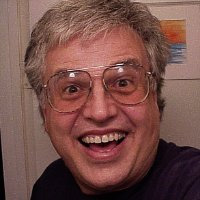
Throughout his programming career, Steve Baker’s efforts usually involved getting the most out of whatever hardware system he was currently working on – sometimes even beyond its perceived limits! In this interview, he reflects on past accomplishments, including the Epyx 2600 ‘Games’ series, and describes his latest project.
Q: Before getting your start into programming, what were you involved with?
Steve Baker: Playing with my HP-25 handheld calculator with 49 programmable steps. But at that time I was 1300 hours into a 1600-hour "training" to be a hairdresser, and a friend turned me on to the HP-25. I watched as he "input" the steps for the lunar lander program and then pressed the R/S (run/stop) key. The display flashed a few times showing various "variables" and then patiently awaited our input. After crashing several times from either too fast a decent (usually due to lack of fuel and a horrible plummeting death) or an experiment in terminal velocity, I was hooked. I went out and got mine the next day.
Q: When did you start working on VCS/2600 games?
Steve Baker: Late in the game. I spent most of my effort doing Apple-II games. Early 80's was involved more with the 5200 game console, then in the late 80's the 2600 again. I loved the simple hardware and task to draw a LIVE TV screen a line at a time - 76 clocks.
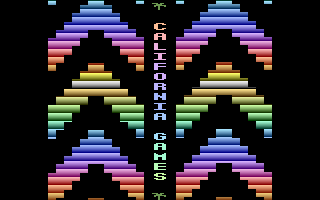
Q: Is California Games the only VCS/2600 title you did?
Steve Baker: I also worked on both Summer Games and Winter Games.
Q: You worked with M. Peter Engelbrite on California Games. What exactly did each of you do in regards to programming it?
Steve Baker: I worked on Half Pipe, Surfing, and the sound engine. He finished Surfing, Foot Bag, and the BMX Bike Racing. The MCP (Main Control Program) was used from the earlier Summer/Winter games. Still to this day I don't know how the Half Pipe event runs with 77 clocks in some frames without tearing the screen. Lucky, I guess.
Q: Very! From what other VCS programmers have told me, it was a very unforgiving machine, especially in t hat aspect (the dreaded "76 cycle blues"). The title screen for VCS/2600 California Games is
a neat effect. Is that your code?
hat aspect (the dreaded "76 cycle blues"). The title screen for VCS/2600 California Games is
a neat effect. Is that your code?
Steve Baker: Nope. It comes from a simple adder. Ain't math great?
Q: Did Peter work on Summer and Winter games too? Did anyone else help you with these?
Steve Baker: Yes, I remember (on Winter Games) Peter did the Bobsled event (Ed: he also did the Luge, Ski Jump, and Hotdog Ski events). I did the speed skating cigarette butts! Graphics have come a loooooooong way.
Q: I had heard that Tod Frye had a hand in Winter Games? Is this correct?
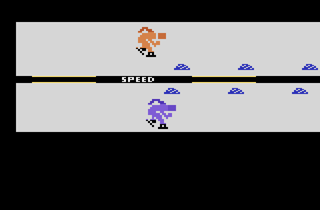 Steve Baker: I know Tod did Swimming for Summer Games and I did Rowing. I'm not sure which one Peter worked on (Ed: Peter did the Pommel Horse event). The Nelson brothers (Craig
and Scott) were working on the MCP for these games and the bank switching which opened the carts up to 16K of ROM (a 4x size increase). I also did the shooting part of the Biathlon event for Winter Games.
Steve Baker: I know Tod did Swimming for Summer Games and I did Rowing. I'm not sure which one Peter worked on (Ed: Peter did the Pommel Horse event). The Nelson brothers (Craig
and Scott) were working on the MCP for these games and the bank switching which opened the carts up to 16K of ROM (a 4x size increase). I also did the shooting part of the Biathlon event for Winter Games.
Q: Are you still in contact with Peter?
Steve Baker: Nah, I have not seen him since the Epyx days. I did run into another Epyx programmer on a trip to L.A. once, at a Denny’s.
Q: Were there any other programmers at Epyx that were involved with games/projects relating to the VCS/2600?
Steve Baker: I know for California Games it was just Peter and myself. There was a guy named Jeremy (last name forgotten) that did work on the Winter and Summer games titles.
Q: Was this a title you wanted to do, or that Epyx assigned?
Steve Baker: Assigned, but I was the closest thing they had to a person who has been there. I surf and skateboard, so those were my assignments. Also, having a MIDI background, I got the “sound” side of things. I made an 87-byte sound engine, with many complex effects, for the Atari 2600.
Q: Were there any technical hurdles you had to overcome in programming California Games?
Steve Baker: I was always squeezed for space, but the hardware was pushed to the max. And little tricks from past Apple-II 6502 programming came in very handy. It helps to think in binary!
Q: Were you a fan of the original C-64 and Atari 400/800 versions of the Games series?
Steve Baker: I helped the programmer and artist on California Games with the Surfing game's animations and "feel". Mostly I played them on the Apple-II.
Q: Was the Atari VCS/2600 the only (game) system you wrote for?
Steve Baker: I also wrote for Mattel’s Intellivision, Apple II, Commodore 64, Atari 400/800/5200, and IBM Intel series - all in assembly language or using language and compilers of my own design.
Q: Do you recall the game titles that you did for those systems?
Steve Baker: I was usually the behind-the-scenes guy. I mainly did hardware drivers and coding in assembly for all of the processors. Most of my best work has never been released, even on the HP-25. I had created a dozen games using 49 steps, or less. There have been a few titles on the Apple II and 5200 that people may remember from the early years, and some educational titles for the Apple-II with D.C. Heath. I did a lot of behind the scenes help with creating sound effects and music for various software titles on the IBM computers. I am a catalyst for others to perform their work. Most of the coding I do today I have done 100's of times in the past so I see things differently than most. I see something in front of me and can duplicate it in software almost instantly. I had a co-worker call me the best coder on the planet. I think in binary.
For the 5200 I did Defender, Stargate, Miniature Golf, and Microgammon SB. The “SB” stands for Super Brain – one of the difficulty settings in the game, or my initials :)
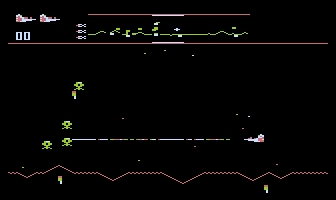 Q: I must say that your Atari version of Defender was simply incredible! Did you have the chance to meet with Eugene Jarvis, when doing your version, or did he offer any help/advice?
Q: I must say that your Atari version of Defender was simply incredible! Did you have the chance to meet with Eugene Jarvis, when doing your version, or did he offer any help/advice?
Steve Baker: I had originally done Defender for the Apple-II as an exercise in programming. Atari wanted it for the 400/800/5200 so that was the 1st game I did for them. Yes, Eugene and I had an informal meeting at a park near Atari, and I just told him how I programmed it from what I saw and he confirmed it. I did find out the Swarmers (little red ones) do not fire behind themselves! It’s a great trick - approach them, get behind them, and then flip around quick and pick them off at your leisure.
Q: Did Atari have a Defender machine in their gameroom for you to use?
Steve Baker: Not for Defender, but when I started Stargate, I used their machine for graphic reference. When it was done, my Stargate screenshots looked like the arcade machine.
Q: Did you reuse any of your Defender code for Stargate?
Steve Baker: Only very small pieces of it like the Task Manager that handles all of the graphics and sound updates. The rest of the code was written from scratch for better speed and used more of the hardware.
That was the final game I did on the Atari 5200. I had created a unique way of having dozens of objects on the screen at t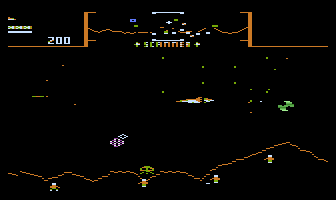 he same time using a combination of player and bitmap graphics. The code only used 2 "players" and was way ahead of
its time. I do still have a running copy for the 5200. I also taught the "sound" people how to timeshare the sounds to produce two-voiced sound effects from a single channel. Stargate even had the same "front end" as the arcade machine, so you could adjust the game to your liking - ALL of this in 16K of 6502 code. I am very good at getting the most out of any hardware and pushing it beyond its limits just to see what happens ;-)
he same time using a combination of player and bitmap graphics. The code only used 2 "players" and was way ahead of
its time. I do still have a running copy for the 5200. I also taught the "sound" people how to timeshare the sounds to produce two-voiced sound effects from a single channel. Stargate even had the same "front end" as the arcade machine, so you could adjust the game to your liking - ALL of this in 16K of 6502 code. I am very good at getting the most out of any hardware and pushing it beyond its limits just to see what happens ;-)
Q: Unfortunately, Stargate was never released for either the 400/800 or 5200 (although a version was released for the VCS/2600), and the only known prototypes are incomplete and suffer from some serious lagging.
Steve Baker: The slowdown is because Stargate used all the 5200's processor due to the variety of graphical techniques used (hi-res, bitmap, and player graphics). I thought I had a later (and slowdown-free) version on an EPROM board somewhere. My original Stargate disks are toast - faded out, magnetic-wise. Ken Van Mersbergen has a copy of the game - I believe the version dated 1/5/84 - and is trying to get me a decompiled listing of it. The slowdown only occurs when you "blow everything up" ie: SmartBomb. Every enemy on screen generates about 15 explosion pieces. If you have a dozen objects, it slows down on the larger waves like 25+ on the screen. If I could locate the explosion queue I could reduce the piece count to half. The front end was just like the arcade, so the SmartBombs should be easy to spot in the code. Finding that code will lead to the explosion for this enemy, and the code that generates the pieces.
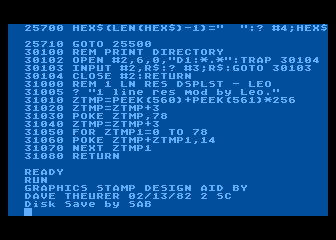 Q: Btw, did you work on an animation program (Graphics
Stamp Design Aid) for the Atari 800? The program was written by Dave Theurer, but there's a comment in the program listing that says "Disk save by SAB".
Q: Btw, did you work on an animation program (Graphics
Stamp Design Aid) for the Atari 800? The program was written by Dave Theurer, but there's a comment in the program listing that says "Disk save by SAB".
Steve Baker: Maybe. I usually did the low level stuff. And I am the only SAB I know. I did in-depth disk read/write work at Apple service. Found an over-write error in their assembler, hence ProDOS assembler was born. It took a while to convince "EDASM's" John Arkley that he had a bug!
Q: Were there other games that you worked on that never got finished, or for whatever reason weren't released?
Steve Baker: I had done a computer vs. player backgammon game on the Apple II, and play-tested it for the 5200. The biggest complaint about it was that it “cheated". Oh well. It had too small an audience anyway. The only people that did like it were those that played backgammon often. I worked on Dick Tracy for the Apple II for over a year, which was one of my best works. It was designed for the Apple IIc or IIe and used a joystick. I had done "too good" of a job on it. Disney told the IBM developers to make their version look as good as mine, but they couldn’t. I had color editing to 4x the normal Apple II hi-res, so I had MORE resolution on the Apple II than the IBM programmers could produce on their machine. The game even had a 25Khz sample of "Calling Dick Tracy..." and 3-voice music with percussion coming out of the single bit Apple-II speaker. So here is another game where I exceeded the limits of the hardware and it was never released.
Q: Do any of your other games have any differences or glitches in them?
Steve Baker: I try to think about the logic first and work it out in my head. By the time I code it, I know it will perform as planned - figure 90% design and about 10% coding. I do not like bugs... yuck.
Q: Did you ever have a game ship and later found a "bug" or something in it, which led to another version being made/released?
Steve Baker: No games. Apple computer changed ROMS from "stock" to "plus" and I had just dup'ed 14,000 service disks. Now they didn't work on the new Apple II Plus versions. So back to drawing board and pulled out the refs to the old monitor ROM code. But I did find bugs in both hardware and software from pushing limits on
some IBM microchannel computers.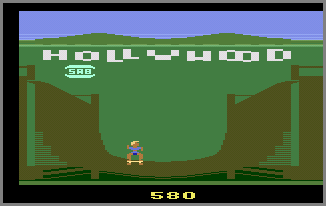
Q: Besides the known VCS California Games Easter egg to reveal your initials (on the half-pipe event), it's rumored that Peter Engelbrite's initials may also be hidden. Is this true?
Steve Baker: Not on that title - code space was very tight. I got mine in because I used part of Half Pipe as code and saved enough bytes to add “SAB”. As far as I know, Peter never put initials in or any tricks, but then again.... ;-)
Q: Besides California Games, do any other games of yours have your initials in them, or possibly some sort of hidden trick/secret?
Steve Baker: The Sporting News Baseball for Apple II and Pilgrim Quest both have hidden secret pictures and animations, but it’s been so long I have forgotten the "keys" to activate them.
Q: Do you still own any of your games for these systems, or any early versions (prototypes) of these games in your possession?
Steve Baker: I have a copy of everything I have done - a true pack rat! I may have a working version of Dick Tracy, but the "key" sheet is gone. David Mullich, the producer at Disney which contracted me to make Dick Tracy, may have a copy of the disk and key.
Q: Were you responsible for writing the instruction manuals for your games?
Steve Baker: Just a few words here and there.
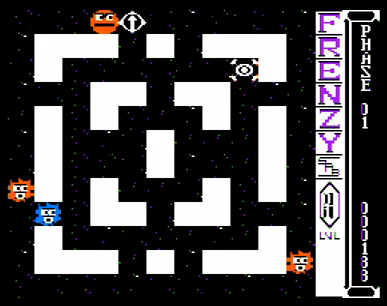 Q: I also found this YouTube video of your Apple II Frenzy game (I'm guessing it's yours since it says "SAB" on the screen), and a
listing for NightCrawler (by SAB Software).
Q: I also found this YouTube video of your Apple II Frenzy game (I'm guessing it's yours since it says "SAB" on the screen), and a
listing for NightCrawler (by SAB Software).
Steve Baker: Yeah! Frenzy was never released, but a few had it at Apple! It was probably found in some box and burned to a CD, or maybe Trip Hawkins at EA leaked it. I had a meeting with him to market the game, and I probably left a copy there. It's an unusual game. You cannot kill yourself by moving into an enemy - they have to move on top of
you, sort of like moving walls that block your path. And the 2nd level "prepare to die stage" was very popular at Apple! Try it - here's the Apple II emulator and a copy of the game HERE. A+Z is up+down, G+H is left+right, and the Space bar release Skull kills whatever touches it.
NightCrawler was the same game as Photar, with different graphics and functions.
Q: What have you been involved with, since working with Epyx?
Steve Baker: I did an educational program here and there, more Sound Design work, little bit of graphics (making Rotographs), and playing with 3-D imaging. When the Internet came along, I started up my own website - SABgames Arcade (Ed.: now SAB Games). It was just a forum to present my games to the world. Many of the games could have been downloaded and placed on websites for free. Others had a small one-time license fee. I found myself using the same snippets of Java code over and over, and decided to combine them into a single applet package called SABfx, and then started writing code in SABfx. It had all the benefits of Java without the complex headaches or compiling, as it used plain text.
I've been doing more PHP and web work lately - heavy on graphic designer, newspaper ads, and newsletters for Melvyn's Restaurant (great place at the Ingleside Inn in Palm Springs).
Q: What are/were some of your favorite games?
Steve Baker: Probably driving games. Atari’s Hard Drivin’, and also the IBM Stunt Driver version that had a "course builder". It may have been called just “Stunts” or “Stunt Driver” (Ed: Microprose’s Stunt Car Racer). It was one of early IBM driving games. Pinball is great. I just got a PS2, which is very cool. SSX for the PS2 is awesome and very well done. Driver for PS also was a very cool, goal-oriented game. Stargate and Defender are always cool!
Q: Unfortunately, the whole arcade coin-op industry seems poised for extinction. Stories have recently circulated about Midway's demise, and the remains of Atari (i.e. Midway West). What's your take on that whole situation, and your predictions for its future (if any)?
Steve Baker: Home gaming hardware is now at or exceeds most arcade machines in the market place. Pinball machines are the most unique, as far as games. Having a BIG screen to play in arcades or racing head-to-head is getting more common, or having a seat for "watchers" - some new “big rig arcade game (Ed: Sega’s 18 Wheeler) was very fun to watch as it was to play. That is what I find missing from most arcades - room for the "watchers" to watch. The games most popular have room around for others to watch and wait to play next.
Q: Since you have a PS2, do you try to stay “current” with what’s out there?
Steve Baker: Nah, I just have tons of PS1 titles! I find the PS1 games run very smoothly and have no hardware "chunkiness" on the “slower” driving games. The Final Fantasy cut scenes run full speed, and have very nicely-smoothed graphics free of pixelization. And what the heck, throw in a CD player and DVD player to boot. It’s a great upgrade. Hardware in hand and game support is what counts. Having a graphics processor twice as fast with no games is not much fun to the end consumer. Games must lead the industry again. Aside from QuickBooks and Video Professor, I have not seen any other ads for computer software. Most are video game ads for N64, PS1, and PS2.
Q: How would you describe your experiences working with Atari and Epyx? Do you have any stories or anecdotes from those days that you recall off the top of your head?
Steve Baker: Crazy! It was at a time when talent was scarce. Atari hired me away from Apple with a offer I couldn't refuse. Even the long time friends at Apple said "Go for it", so I did. That was 1982. I was at Atari from 1982 through 1984 (well, I worked from home until last few months of their "core hours"). I’ve been working at home ever since. Other Atari experiences, shall we say, are best left unsaid! ;-)
| GAME | SYSTEM | COMPANY | STATUS |
| "backgammon" or "microgammon"? | Apple II | not released | |
| Defender | Apple II | Atarisoft | not released |
| Dick Tracy | Apple II | Disney | not released |
| Frenzy | Apple II | SAB Software | not released |
| Photar (aka NightCrawler) | Apple II | SAB Software/Softape | released |
| The Sporting News Baseball | Apple II | Epyx | released |
| Star Mines | Apple II | Softape | released |
| California Games | Atari VCS/2600 | Epyx | released |
| Summer Games | Atari VCS/2600 | Epyx | released |
| Winter Games | Atari VCS/2600 | Epyx | released |
| Graphics Stamp Design Aid | Atari 400/800 | Atari | (internal use only) |
| Gomoku | Atari 400/800 | ArtSci | released |
| Reversi | Atari 400/800 | ArtSci | released |
| Defender | Atari 400/800/5200 | Atari | released |
| Microgammon SB | Atari 400/800/5200 | Atari | not released |
| Miniature Golf | Atari 400/800/5200 | Atari | not released |
| Stargate | Atari 400/800/5200 | Atari | not released |
| diagnotic/monitor tools | Intellivision | Mattel | |
| Passport MIDI software | C-64 | ||
| Alien Legacy | PC | ||
| Colony Quest | PC | ||
| Pilgrim Quest | PC |